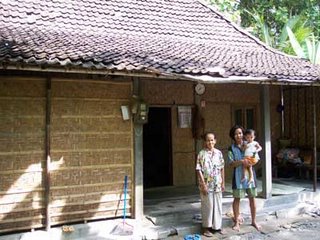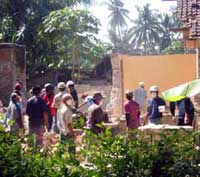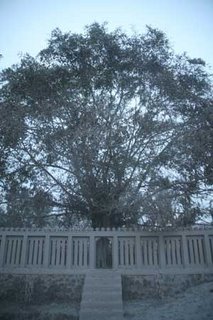BEBEKAN 7

In the last few days, I finally looked for the first time at the photographs which the students took two days after the earthquake in the village of Bebekan with each family in front of their destroyed house. It is a poignant spectacle, and above all they bring out the obvious conclusion that it is not a “natural disaster” (bencana alam), but a social catastrophe. Almost all the houses which collapsed in the south of Yogya are houses of poor people. The French firemen who came in the village said that they all were very badly built, with bricks of bad quality, bad cement, and without any elementary technique of sound construction. In Japan, a 5.9 earthquake does not destroy any house. And now the government has announced that it will give between 10 and 30 million rps per destroyed house. However several qualified architects say that to build an earthquake-resistant house out of cement and concrete is expensive, because one needs a lot of iron and good techniques. The villagers will thus not be able to rebuilt a solid house, they have already collected undamaged bricks in their ruins to re-use them for their next house ! The firemen picked up some of these bricks but when subjected to a very small pressure, the bricks crumbled to dust. The money is thus not an assistance but a kind of crime : one gives to the villagers the means not to build a house but a tomb for their children. The only cheap solution seems to be bamboo, which is inexpensive and earthquake-resistant. Wood is too expensive. The only undamaged house of Bebekan is a bamboo house built on a high base, with a terrace made of cement supported by concrete pillars reinforced with iron bars going down 50cm in the ground. The bamboo walls were set up between the concrete pillars. It is the peasant himself who built this house in 1965. Not a single tile has fallen from the roof ! The problem is that he changes every year the bamboo partitions because they are devoured by animals. It must be must be less expensive for him to change the walls than to buy products against insects.
The money is thus not an assistance but a kind of crime : one gives to the villagers the means not to build a house but a tomb for their children. The only cheap solution seems to be bamboo, which is inexpensive and earthquake-resistant. Wood is too expensive. The only undamaged house of Bebekan is a bamboo house built on a high base, with a terrace made of cement supported by concrete pillars reinforced with iron bars going down 50cm in the ground. The bamboo walls were set up between the concrete pillars. It is the peasant himself who built this house in 1965. Not a single tile has fallen from the roof ! The problem is that he changes every year the bamboo partitions because they are devoured by animals. It must be must be less expensive for him to change the walls than to buy products against insects.
We will begin a program at Bebekan, one evening per week : projection of photographs of their destroyed houses and testimonials by the villagers on how they built before the earthquake; afterwards, projection of Japanese houses made of wood and bamboo, of trendy Balinese houses made of bamboo, or other alternatives.
Sunday I went to get the four men of the village with whom we have had the closest contact since the beginning. I brought them to my house on the slopes of the volcano to discuss their ideas for rebuilding. To get out of the ruins of their village made them feel very good. Present also were Asep and Faiz (the SAR student in charge of the posko in Bebekan), and an Indonesian architect and friend, Retno, accompanied by her husband, professor of cinema at the Yogyakarta Academy of Fine Arts (ISI). The villagers told us that in Bebekan there were many insects of all sorts which devoured bamboo and wood, a true calamity. It would thus be necessary to find out what special treatment for the bamboo could prevent this. Retno, the architect, suggested that a first step would be to make the foundations with much more sand. The previous custom was to put 5 cm of sand in the foundations, but from now on it would be necessary to put at least 20 cm. The great lesson from this earthquake came from the houses of Parangtritis, a small resort town built on the coast south of Yogya. This town was just beside the epicenter of the earthquake, at a distance of 7 km in the ocean. Practically none of these houses collapsed, thanks to the sand on which they were built and which dampened the vibrations.
Retno suggested to draft a budget for a basic earthquake-resistant structure : a foundation (with sand), a frame of 6 reinforced concrete pillars well anchored in the ground, and a “concrete crown” at the top joining together the 6 pillars. It would be the basis of the standard house. From there, each family could “fill it” with whatever they wish or can afford : walls made of bamboo or wood, or even of bricks (if the framework holds, a collapsing brick wall will fall vertically without much danger), roof made of tiles or metal sheet, windows and doors recovered from their old houses. Just speaking about rebuilding and to be able to project themselves in the future made these men feel very happy. In fact, they had stopped in the last week demolishing the walls still standing and clearing the ruins : it plunged them in a silent depression. They also stopped because they must work in the rice fields : 75% of the villagers earn their living as farm laborers. If they had given up the rice fields to clear their ruins, the rice fields would drain and die.
We told them that nonetheless it was essential that they do not stop clearing their ruins, otherwise they will never get out of their depression. The spectacle of these ruins is oppressive, they always live on the mountains of rubble left by their collapsed houses, in the dust, without a flat ground to install a large tent. They thus came up with the idea to organize a tour of duty on the same basis as the night guard duty, known as “ronda”.  Each day, a group of 18 men will not go to work in the rice fields but stay in the village to continue the laborious clearing of the rubble. As of Monday morning, they had posted in the village a list of the groups of 18 men, their names and their schedule for the “ronda” and the rubble-clearing day. To support them, we decided to give money to the women so that they can cook for this group of men each day. Thus, clearing the ruins has started again, not through a big injection of funds, but through a stimulus, a few hours of discussion, and 4 euros a day to cook for the 18 men. Sunday, all the men of the village will work together to further the clearing of the rubble, and we will support them by giving to the women the means to cook for all the workers “gotong-royong”. As of this Monday, the new system has worked very well and clearing progresses, even if it will take several more weeks to complete.
Each day, a group of 18 men will not go to work in the rice fields but stay in the village to continue the laborious clearing of the rubble. As of Monday morning, they had posted in the village a list of the groups of 18 men, their names and their schedule for the “ronda” and the rubble-clearing day. To support them, we decided to give money to the women so that they can cook for this group of men each day. Thus, clearing the ruins has started again, not through a big injection of funds, but through a stimulus, a few hours of discussion, and 4 euros a day to cook for the 18 men. Sunday, all the men of the village will work together to further the clearing of the rubble, and we will support them by giving to the women the means to cook for all the workers “gotong-royong”. As of this Monday, the new system has worked very well and clearing progresses, even if it will take several more weeks to complete.
We will rent a van to transport the rubble on the dirt roads leading to the village. Unless Vincent, the French friend of Yogya which also supports Bebekan and which has become an expert in the recovery and the redistribution of large stocks of stagnant assistance in the warehouses of the international NGOs, buys a van and lends it to us on certain days. As for governmental assistance, the monthly aid (90,000 rps) which all the victims of the earthquake are entitled to receive still has not arrived in Bebekan. Other villages are in the same situation and some have expressed their discontent more or less violently. The students of the posko will put pressure on the local authorities to induce them to release the sums due to the people of Bebekan. An issue to be followed closely. It is clear that the people of Bebekan do really believe that they will ever receive the promised assistance for rebuilding (between 10 and 30 million rps). Moreover, in the last two weeks, the price of all building materials has doubled in Yogyakarta. Even bamboo panels (gedek) have gone from 20,000 to 40,000 rps.
In the north, the Merapi volcano is still very active and Vincent is lobbying with great success with the international NGOs to obtain logistical aid, in particular pumps and watertanks. Following the great volcanic cloud and the lava and magma flows which have covered Kaliadem and the bunker, the drains which transport water from the top of the volcano to the higher villages were all crushed. Monday, I went up to see the guardian of the volcano, Mbah Maridjan. His village is covered with white ashes. The volcanic cloud passed at a distance of 500 m from his house. They do not have any more water. The cows do not have anything to drink and they cannot graze the grass buried under ashes and sulfur. Certain desperate peasants sell off their cows to callous speculators who buy them at a very low price.
International NGOs do not really understand the Javanese “village” culture. They are used to intervene in refugee camps. However, as well for the victims of the earthquake in the south as for the inhabitants of the volcano in the north, people did not gather in big camps but remained in their villages. On the volcano, women and children sleep in the camps set up downwards, part of the men remain in the villages near the summit, and during the day, everyone goes up to the village to take care of the animals and the fields. One thus needs cisterns and water pumps not only in the refugee camps, but also in the villages. When refugees are parked in camps, they become the “objects” of the NGOs, easy to manage and organize. In the villages however, people, even when they are victims, remain in charge of their lives. It is a remarkable fact to observe, as well on the earthquake side as on the volcano side.
I would like to explain why, although we are very involved and focused on Bebekan, the earthquake and the volcano are linked in our actions and our hearts. For more than a month, in April and May, everyone was focused on the volcano and the terrible threat of a fatal eruption. Almost everyone found that Mbah Maridjan, the guardian of the volcano, was unnecessarily and dangerously stubborn in his decision to remain in his village and in his refusal to be evacuated. Then suddenly, it is the earth which shook in the south. After which all the aid moved south and the volcano was forgotten. The only vigilant people were the SAR group : on the day of the earthquake, Saturday May 27, they split themselves into two groups: half of them would focus below on the earthquake, the remaining half on the volcano.

I work with Asep (from SAR) on Bebekan. Now that the casualties of the earthquake have all been evacuated, Asep, after a day spent working in Bebekan, goes up practically every evening to the SAR posko called Relawan Siaga Merapi. Often I accompany him by car since their station is only 15 minutes away from my house. I am thus briefed on all the problems up there, especially on the day of the enormous volcanic cloud which hit Kaliadem. Furthermore, I cannot forget that the guardian of the volcano has adopted me as a member of his family.
Since the earthquake, people did not think any more of the volcano. So much so that the French Firemen Without Borders came only with medical material for the casualties of the earthquake. When, after the big volcanic cloud, I led them at night to the posko of Merapi in order to help rescue the two men locked in the bunker, they did not have fire-resistant equipment ! Furthermore, on another level, the volcano represents verticality (spirituality), and the southern villages destroyed by the earthquake represent horizontality (this material world). To achieve right action, it is necessary to endeavor to cultivate a balance between these two axes, and even to stand at their intersection. I understood this only Monday evening as I was coming back from the house of Mbah Maridjan.
 We also went to see the White Banyan Tree and the Elephant Stone. They stood in the middle of a lunar universe, buried, burnt by ashes, precisely where the bunker was. We did not stay very long because it was very dangerous, at any minute a new volcanic cloud could emerge. And since the volcano was covered and the evening fog was beginning to surround us, one would not have seen the deadly cloud coming. Moreover, the antennas which record the sound of the formation of a volcanic cloud had been damaged by the eruption of last Wednesday. The SAR rescuers cannot any more pick up this warning sound on their radio and their talkie-walkie and transmit an alarm. But these volunteers, which all knew my book “The White Banyan Tree” (on the myths surrounding the Merapi volcano, the dreams of the guardian of the volcano, and the two sacred sites called the White Banyan Tree and the Elephant Stone, published in 1998), absolutely wanted to show me the miracle : the volcanic cloud and the lava flows had passed behind the white banyan tree and stopped at the elephant stone, exactly in accordance with the legend that Mbah Maridjan tells about in “The White Banyan Tree”: “The Elephant Stone is an old story, dating from the time when the first lava flow went down to the south and dug the river of the Anyar mountain. According to this story, the volcanic lava and stones abruptly stopped in their tracks in order to save a pregnant woman. Since then, nobody has ever dared disturb this stone or destroy it…”
We also went to see the White Banyan Tree and the Elephant Stone. They stood in the middle of a lunar universe, buried, burnt by ashes, precisely where the bunker was. We did not stay very long because it was very dangerous, at any minute a new volcanic cloud could emerge. And since the volcano was covered and the evening fog was beginning to surround us, one would not have seen the deadly cloud coming. Moreover, the antennas which record the sound of the formation of a volcanic cloud had been damaged by the eruption of last Wednesday. The SAR rescuers cannot any more pick up this warning sound on their radio and their talkie-walkie and transmit an alarm. But these volunteers, which all knew my book “The White Banyan Tree” (on the myths surrounding the Merapi volcano, the dreams of the guardian of the volcano, and the two sacred sites called the White Banyan Tree and the Elephant Stone, published in 1998), absolutely wanted to show me the miracle : the volcanic cloud and the lava flows had passed behind the white banyan tree and stopped at the elephant stone, exactly in accordance with the legend that Mbah Maridjan tells about in “The White Banyan Tree”: “The Elephant Stone is an old story, dating from the time when the first lava flow went down to the south and dug the river of the Anyar mountain. According to this story, the volcanic lava and stones abruptly stopped in their tracks in order to save a pregnant woman. Since then, nobody has ever dared disturb this stone or destroy it…”Thank you and until the next installment
Elisabeth

0 Comments:
Post a Comment
<< Home